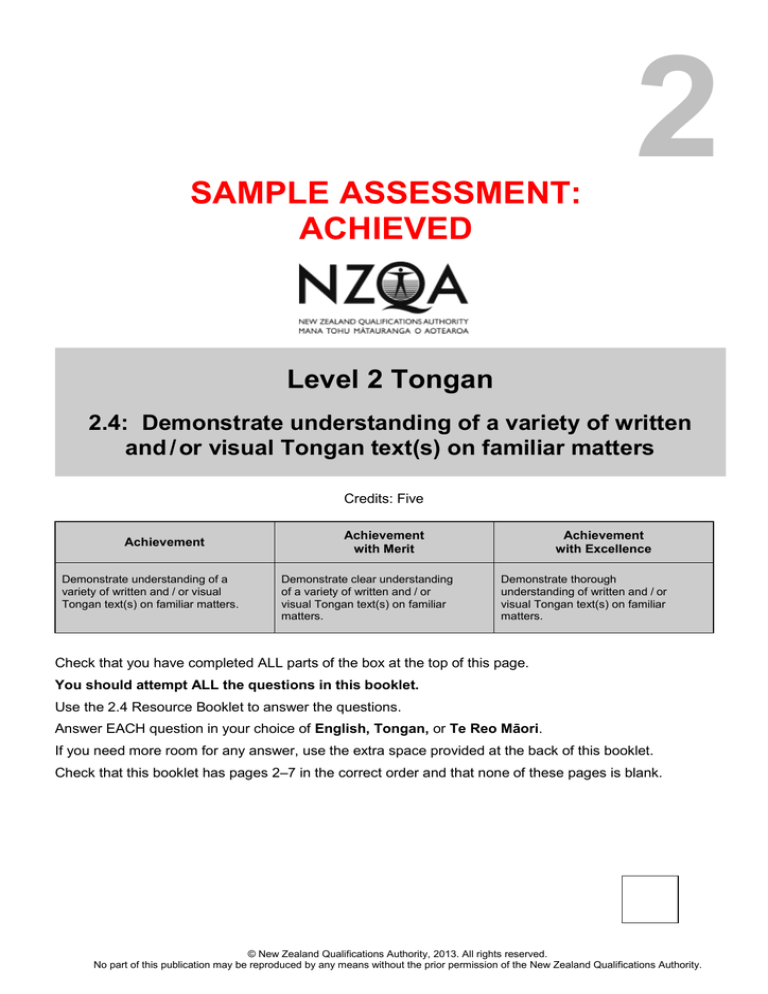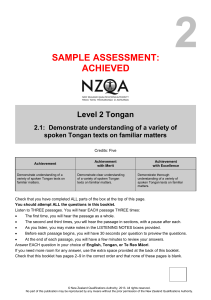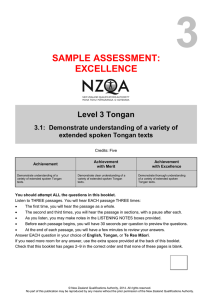
SAMPLE ASSESSMENT:
ACHIEVED
2
Level 2 Tongan
2.4: Demonstrate understanding of a variety of written
and / or visual Tongan text(s) on familiar matters
Credits: Five
Achievement
Demonstrate understanding of a
variety of written and / or visual
Tongan text(s) on familiar matters.
Achievement
with Merit
Demonstrate clear understanding
of a variety of written and / or
visual Tongan text(s) on familiar
matters.
Achievement
with Excellence
Demonstrate thorough
understanding of written and / or
visual Tongan text(s) on familiar
matters.
Check that you have completed ALL parts of the box at the top of this page.
You should attempt ALL the questions in this booklet.
Use the 2.4 Resource Booklet to answer the questions.
Answer EACH question in your choice of English, Tongan, or Te Reo Māori.
If you need more room for any answer, use the extra space provided at the back of this booklet.
Check that this booklet has pages 2–7 in the correct order and that none of these pages is blank.
© New Zealand Qualifications Authority, 2013. All rights reserved.
No part of this publication may be reproduced by any means without the prior permission of the New Zealand Qualifications Authority.
2
Ngāue‘aki ‘a e houa ‘e taha ke tali ‘a e ngaahi fehu‘i ‘i he pepa ni.
You are advised to spend one hour answering the questions in this booklet.
FIRST TEXT: ‘Kātinia’
Lau e lea ‘o e hiva ‘i he peesi 2 ‘o e pepa ‘oku ‘i ai e ngaahi konga tohi. Ngāue‘aki ia ke tali ‘a e
Fehu‘i ‘Uluaki.
Read the song lyrics on page 2 of the resource booklet. Use them to answer Question One.
FEHU‘I ‘ULUAKI – QUESTION ONE
Ko e hiva ko ‘eni ko e ‘faka‘ānaua ki he tokotaha kuo ‘osi mate.
Tohi mai e laini ‘e tolu mei he fo‘i hiva ‘oku ne poupou‘i e lau ko ‘eni pea ke fakamatala‘i hono
‘uhinga ‘o e laini takitaha.
This song expresses grief for a person who has passed away.
Write three lines from the song that support this statement and explain why in reference to the text.
Laini 1 / Line 1
Stanza 1, lines 3 or 4
Fakamatala / Explanation
Line 3 – mind shows memories.
Line 4 – tears show crying for someone who dies.
Laini 2 / Line 2
Stanza 2, lines 1, 2, or 3
Fakamatala / Explanation
Line 1 – shows that promise is gone because he is dead.
Line 2 – shows that promise is cold.
Line 3 – the heart is crying.
Laini 3 / Line 3
Stanza 3, lines 1, 2, 3, or 4
Fakamatala / Explanation
Line 1 – did not think of what will happen.
Line 2 – did not know about death. Line 3 – mind shows memories.
Line 4 – tears shows crying for someone who dies.
Tongan 2.4 Sample assessment: Achieved
Ke
ngāue‘aki
pē ‘e he
fai sivi
Assessor’s
use only
3
SECOND TEXT: Mo‘ui pe mate
Lau e tohi pea ke siofi fakalelei ‘a e fakatātā ‘i he peesi 3 ‘o e pepa ‘oku ‘i ai ‘a e ngaahi konga
tohi. Ngāue‘aki ia ke tali e Fehu‘i Ua.
Study the image and text on page 3 of the resource booklet. Use them both to answer Question
Two.
FEHU‘I UA – QUESTION TWO
(a)
Fakafonu e ngaahi puha ‘i lalo.
Fill in the boxes in this diagram.
KEMIKALE
OLA KOVI ‘O E IFI TAPAKA
Lung cancer
Discolouration
IFI TAPAKA
Nicotine
Addiction
Asthma
(b)
Mo fakamatala‘i ‘a e ola kovi ‘o e ifi tapaka.
Give an explanation of the bad effects of smoking.
Smoking is bad for your health. Smokers get addicted and have diseases.
Tongan 2.4 Sample assessment: Achieved
Ke
ngāue‘aki
pē ‘e he
fai sivi
Assessor’s
use only
4
THIRD TEXT: Mape folau ki he mo‘ui
Lau ‘a e konga tohi ‘i he peesi 4 ‘o e pepa ‘oku ‘i ai e ngaahi konga tohi. Ngāue‘aki ia ke tali e
Fehu‘i Tolu mo e Fehu‘i Fā.
Read the text on page 4 of the resource booklet. Use it to answer Question Three and Question
Four.
FEHU‘I TOLU – QUESTION THREE
(a)
Mei he palakalafi hono 2, tohi ‘a e ‘uhinga ‘e 3 ‘oku ne pukepuke ‘a e fe‘ofa‘aki,
fe‘ofo‘ofani mo e ngāue fakataha ‘a e ki‘i fāmili.
From paragraph 2, give three reasons why this family still practise reciprocity, unity, and
solidarity.
‘Uhinga 1 / Reason 1
Love for their relatives; love for one another.
‘Uhinga 2 / Reason 2
Love for their neighbours; helping others.
‘Uhinga 3 / Reason 3
Have endurance.
(b)
Fakatatau ki ho‘o tali ‘i he Fehu‘i 3 (a), ‘oku ke pehē ko e fakakaukau fakapotopoto eni pe
‘ikai?
Based on your answers to Question 3 (a), do you think this is a good or a bad idea? Why?
Yes, because these are the reasons that keep a family united.
Tongan 2.4 Sample assessment: Achievement
Ke
ngāue‘aki
pē ‘e he
fai sivi
Assessor’s
use only
5
FEHU‘I FĀ – QUESTION FOUR
(a)
Tohi ‘a e lēsoni ‘e tolu na‘e ako ‘e he tokotaha fa‘u tohi mei he‘ene ongo mātu‘a.
Write three lessons that the writer learns from his parents.
Lēsoni 1 / Lesson 1
Loving and faithful to each other.
Lēsoni 2 / Lesson 2
Learn how to negotiate.
Lēsoni 3 / Lesson 3
Learn how to do business.
(b)
Ko e hā hono ‘aonga ‘o e ngaahi lēsoni ko ‘eni kiate koe ‘i he kaha‘u?
Why would these lessons be useful to him in the future?
It serves as his road map.
Tongan 2.4 Sample assessment: Achievement
Ke
ngāue‘aki
pē ‘e he
fai sivi
Assessor’s
use only
6
Konga ‘oku ‘atā ‘o ka fiema‘u.
Extra space if required.
Tohi ‘a e fika ‘o e fehu‘i ‘o ka fiema‘u.
Write the question number(s) if applicable.
Fika ‘o e
fehu‘i
Question
number
Tongan 2.4 Sample assessment: Achieved
Ke
ngāue‘aki
pē ‘e he
fai sivi
Assessor’s
use only
7
Konga ‘oku ‘atā ‘o ka fiema‘u.
Extra space if required.
Tohi ‘a e fika ‘o e fehu‘i ‘o ka fiema‘u.
Write the question number(s) if applicable.
Fika ‘o e
fehu‘i
Question
number
Tongan 2.4 Sample assessment: Achieved
Ke
ngāue‘aki
pē ‘e he
fai sivi
Assessor’s
use only






